
Ore resources on Mars
Encyclopedia
Mars may contain valuable ores
that will be very useful to future colonists. The abundance of volcanic features together with widespread cratering are strong evidence for a variety of ores.
. When magma sits in underground chambers, slowly cooling over thousands of years, heavier elements sink. These elements, including copper
, chromium
, iron
, and nickel
become concentrated at the bottom. When the mass of magma has cooled down and has mostly frozen or crystallized into a solid, a small amount of liquid remains. This liquid bears important substances such as lead
, silver
, tin
, bismuth
, antimony
. When magma is fresh and hot, many elements are free to move. Later, as cooling proceeds, the elements hook up or bind with each other to form chemical compounds or minerals. Some hook up quickly, others much later. Because some elements do not fit easily into minerals (some are just too big), they often exist as free elements even after nearly all the other elements have formed minerals. These remaining elements are called incompatible elements. Some of them are quite useful for our species: niobium
, a metal used in producing superconductors and specialty steel
s, lanthanum
and neodymium
used by Toyota to build its Prius cars, europium
for television monitors and energy-efficient LED
light bulbs Sometimes minerals are so hot in the magma chamber that they are in the form of a gas. Others are mixed with water and sulfur
. The gases and mineral-rich solutions eventually work their way into cracks and become valuable minerals veins. Ore minerals, including the incompatible elements, remain dissolved in the hot solution, then crystallize out when the solution cools. Hot liquids can hold much more solid in solution, just as hot tea can hold more sugar then cold tea. Deposits created by means of these hot solutions are called hydrothermal deposits. Some of the world's most significant deposits of gold
, silver, lead, mercury
, zinc
, and tungsten
started out this way. Nearly all the mines in northern Black Hills of South Dakota came to be because of hot water desposits of valuable minerals. Cracks often form when a mass of magma
cools because magma, like most substances, contracts when it cools. Cracks occur both in the frozen magma mass and in the surrounding rocks, so ore is deposited in any kind of the rock that happens to be nearby, but the ore minerals first had to be concentrated by way of a hot, molten mass of magma.
--the largest volcano in the solar system. Even Ceraunius Tholus
, one of its smaller volcanoes, nears the height of Earth's Mt. Everest.
What's more there is strong evidence for much more widespread sources of heat in the form of dikes
, which indicate that magma traveled under the ground. Dikes take the shape of walls and cut across rock layers. In some cases dikes on Mars have become exposed by erosion
.
Large areas of Mars contain troughs, called fossa, which are classified as grabens by geologists. They stretch thousands of miles out from volcanoes. It is believed that dikes helped with the formation of grabens. Many, maybe most, of the grabens had dikes under them. One would expect dikes and other igneous intrusions on Mars because geologists believe that the amount of liquid rock that moved under the ground is more than what we see on the top in the form of volcanoes and lava flows.
On Earth, vast volcanic landscapes are called "large Igneous Provinces" (LIP's); such places are sources of nickel, copper, titanium
, iron, platinum, palladium
, and chromium
. Mars's Tharsis
region contains a group of giant volcanoes, is considered to be an LIP.
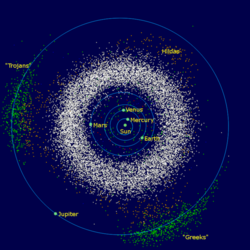 Besides heat generated by molten rock, Mars has had much heat produced when asteroids impacted its surface making giant craters
Besides heat generated by molten rock, Mars has had much heat produced when asteroids impacted its surface making giant craters
. The area around a large impact may take hundreds of thousands of years to cool.
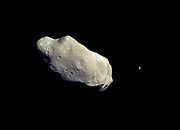 During that time, ice in the ground will melt, heat, dissolve minerals, then deposit them in cracks or faults that were produced with the impact. Studies on the earth have documented that cracks are produced and that secondary minerals veins are filled in the cracks. Images from satellites orbiting Mars have detected cracks near impact craters. The surface of Mars contains abundant evidence of a wetter climate in the past along with ice frozen in the ground. NASA
During that time, ice in the ground will melt, heat, dissolve minerals, then deposit them in cracks or faults that were produced with the impact. Studies on the earth have documented that cracks are produced and that secondary minerals veins are filled in the cracks. Images from satellites orbiting Mars have detected cracks near impact craters. The surface of Mars contains abundant evidence of a wetter climate in the past along with ice frozen in the ground. NASA
's Mars Odyssey actually measured the distribution of ice from orbit with a gamma ray spectrometer
.ref>http://mars.jpl.nasa.nasa.gov/odyssey/newsroom/pressreleases/20020528a.html This process, called hydrothermal alteration has been found in a meteorite from Mars. Research, published in February 2011, detailed the discovery of clay minerals, serpentine, and carbonate in the veins of a Nakhlite martian meteorite. The Phoenix lander, whose rocket engine blast actually exposed a layer of ice, watched ice melt (the ice disappeared by sublimation).
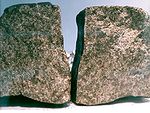 It has for some time been accepted by the scientific community that a group of meteorites came from Mars. As such, they represent actual samples of the planet and have been analyzed on Earth by the best equipment available. In these meteorites, called SNCs, many valuable elements have been detected. Magnesium
It has for some time been accepted by the scientific community that a group of meteorites came from Mars. As such, they represent actual samples of the planet and have been analyzed on Earth by the best equipment available. In these meteorites, called SNCs, many valuable elements have been detected. Magnesium
, Aluminium
, Titanium
, Iron, and Chromium are relatively common in them. In addition, lithium
, cobalt
, nickel, copper, zinc, niobium, molybdenum
, lanthanum, europium, tungsten, and gold have been found in trace amounts. It is quite possible that in some places these materials may be concentrated enough to be mined.
The Mars landers Viking I, Viking II, Pathfinder, Opportunity Rover
, and Spirit Rover
identified aluminium, iron, magnesium
, and titanium in the Martian soil. Opportunity found small structures, named "blueberries" which were found to be rich in hematite
, a major ore of iron. These blueberries could easy be gathered up and reduced to metallic iron that could be used to make steel.
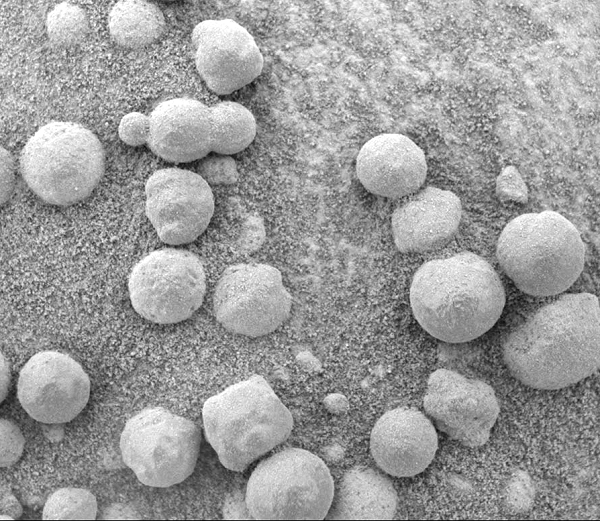 In addition,both Spirit and Opportunity Rovers found nickel-iron meteorites sitting on the surface of Mars. These could also be used to produce steel
In addition,both Spirit and Opportunity Rovers found nickel-iron meteorites sitting on the surface of Mars. These could also be used to produce steel
.
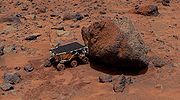
Dark sand dunes are common on the surface of Mars. Their dark tone is due to the volcanic rock called basalt. The basalt dunes are believed to contain the valuable minerals chromite
, magnetite
, and ilmenite
. Since the wind has gathered them together, they do not even have to be mined, merely scooped up. These minerals could supply future colonists with chromium, iron, and titanium.
.
Orés
Orés is a municipality in the Cinco Villas, in the province of Zaragoza, in the autonomous community of Aragon, Spain. It belongs to the comarca of Cinco Villas. It is placed 104 km to the northwest of the provincial capital city, Zaragoza. Its coordinates are: 42° 17' N, 1° 00' W, and is...
that will be very useful to future colonists. The abundance of volcanic features together with widespread cratering are strong evidence for a variety of ores.
How deposits are made
A strong tenet of basic geology is that ore deposits are produced with the help of large amounts of heat. On Mars, heat can come from molten rock moving under the ground and from crater impacts. Liquid rock under the ground is called magmaMagma
Magma is a mixture of molten rock, volatiles and solids that is found beneath the surface of the Earth, and is expected to exist on other terrestrial planets. Besides molten rock, magma may also contain suspended crystals and dissolved gas and sometimes also gas bubbles. Magma often collects in...
. When magma sits in underground chambers, slowly cooling over thousands of years, heavier elements sink. These elements, including copper
Copper
Copper is a chemical element with the symbol Cu and atomic number 29. It is a ductile metal with very high thermal and electrical conductivity. Pure copper is soft and malleable; an exposed surface has a reddish-orange tarnish...
, chromium
Chromium
Chromium is a chemical element which has the symbol Cr and atomic number 24. It is the first element in Group 6. It is a steely-gray, lustrous, hard metal that takes a high polish and has a high melting point. It is also odorless, tasteless, and malleable...
, iron
Iron
Iron is a chemical element with the symbol Fe and atomic number 26. It is a metal in the first transition series. It is the most common element forming the planet Earth as a whole, forming much of Earth's outer and inner core. It is the fourth most common element in the Earth's crust...
, and nickel
Nickel
Nickel is a chemical element with the chemical symbol Ni and atomic number 28. It is a silvery-white lustrous metal with a slight golden tinge. Nickel belongs to the transition metals and is hard and ductile...
become concentrated at the bottom. When the mass of magma has cooled down and has mostly frozen or crystallized into a solid, a small amount of liquid remains. This liquid bears important substances such as lead
Lead
Lead is a main-group element in the carbon group with the symbol Pb and atomic number 82. Lead is a soft, malleable poor metal. It is also counted as one of the heavy metals. Metallic lead has a bluish-white color after being freshly cut, but it soon tarnishes to a dull grayish color when exposed...
, silver
Silver
Silver is a metallic chemical element with the chemical symbol Ag and atomic number 47. A soft, white, lustrous transition metal, it has the highest electrical conductivity of any element and the highest thermal conductivity of any metal...
, tin
Tin
Tin is a chemical element with the symbol Sn and atomic number 50. It is a main group metal in group 14 of the periodic table. Tin shows chemical similarity to both neighboring group 14 elements, germanium and lead and has two possible oxidation states, +2 and the slightly more stable +4...
, bismuth
Bismuth
Bismuth is a chemical element with symbol Bi and atomic number 83. Bismuth, a trivalent poor metal, chemically resembles arsenic and antimony. Elemental bismuth may occur naturally uncombined, although its sulfide and oxide form important commercial ores. The free element is 86% as dense as lead...
, antimony
Antimony
Antimony is a toxic chemical element with the symbol Sb and an atomic number of 51. A lustrous grey metalloid, it is found in nature mainly as the sulfide mineral stibnite...
. When magma is fresh and hot, many elements are free to move. Later, as cooling proceeds, the elements hook up or bind with each other to form chemical compounds or minerals. Some hook up quickly, others much later. Because some elements do not fit easily into minerals (some are just too big), they often exist as free elements even after nearly all the other elements have formed minerals. These remaining elements are called incompatible elements. Some of them are quite useful for our species: niobium
Niobium
Niobium or columbium , is a chemical element with the symbol Nb and atomic number 41. It's a soft, grey, ductile transition metal, which is often found in the pyrochlore mineral, the main commercial source for niobium, and columbite...
, a metal used in producing superconductors and specialty steel
Steel
Steel is an alloy that consists mostly of iron and has a carbon content between 0.2% and 2.1% by weight, depending on the grade. Carbon is the most common alloying material for iron, but various other alloying elements are used, such as manganese, chromium, vanadium, and tungsten...
s, lanthanum
Lanthanum
Lanthanum is a chemical element with the symbol La and atomic number 57.Lanthanum is a silvery white metallic element that belongs to group 3 of the periodic table and is the first element of the lanthanide series. It is found in some rare-earth minerals, usually in combination with cerium and...
and neodymium
Neodymium
Neodymium is a chemical element with the symbol Nd and atomic number 60. It is a soft silvery metal that tarnishes in air. Neodymium was discovered in 1885 by the Austrian chemist Carl Auer von Welsbach. It is present in significant quantities in the ore minerals monazite and bastnäsite...
used by Toyota to build its Prius cars, europium
Europium
Europium is a chemical element with the symbol Eu and atomic number 63. It is named after the continent of Europe. It is a moderately hard silvery metal which readily oxidizes in air and water...
for television monitors and energy-efficient LED
LEd
LEd is a TeX/LaTeX editing software working under Microsoft Windows. It is a freeware product....
light bulbs Sometimes minerals are so hot in the magma chamber that they are in the form of a gas. Others are mixed with water and sulfur
Sulfur
Sulfur or sulphur is the chemical element with atomic number 16. In the periodic table it is represented by the symbol S. It is an abundant, multivalent non-metal. Under normal conditions, sulfur atoms form cyclic octatomic molecules with chemical formula S8. Elemental sulfur is a bright yellow...
. The gases and mineral-rich solutions eventually work their way into cracks and become valuable minerals veins. Ore minerals, including the incompatible elements, remain dissolved in the hot solution, then crystallize out when the solution cools. Hot liquids can hold much more solid in solution, just as hot tea can hold more sugar then cold tea. Deposits created by means of these hot solutions are called hydrothermal deposits. Some of the world's most significant deposits of gold
Gold
Gold is a chemical element with the symbol Au and an atomic number of 79. Gold is a dense, soft, shiny, malleable and ductile metal. Pure gold has a bright yellow color and luster traditionally considered attractive, which it maintains without oxidizing in air or water. Chemically, gold is a...
, silver, lead, mercury
Mercury (element)
Mercury is a chemical element with the symbol Hg and atomic number 80. It is also known as quicksilver or hydrargyrum...
, zinc
Zinc
Zinc , or spelter , is a metallic chemical element; it has the symbol Zn and atomic number 30. It is the first element in group 12 of the periodic table. Zinc is, in some respects, chemically similar to magnesium, because its ion is of similar size and its only common oxidation state is +2...
, and tungsten
Tungsten
Tungsten , also known as wolfram , is a chemical element with the chemical symbol W and atomic number 74.A hard, rare metal under standard conditions when uncombined, tungsten is found naturally on Earth only in chemical compounds. It was identified as a new element in 1781, and first isolated as...
started out this way. Nearly all the mines in northern Black Hills of South Dakota came to be because of hot water desposits of valuable minerals. Cracks often form when a mass of magma
Magma
Magma is a mixture of molten rock, volatiles and solids that is found beneath the surface of the Earth, and is expected to exist on other terrestrial planets. Besides molten rock, magma may also contain suspended crystals and dissolved gas and sometimes also gas bubbles. Magma often collects in...
cools because magma, like most substances, contracts when it cools. Cracks occur both in the frozen magma mass and in the surrounding rocks, so ore is deposited in any kind of the rock that happens to be nearby, but the ore minerals first had to be concentrated by way of a hot, molten mass of magma.
Molten rock on Mars
The surface of Mars displays areas of great heat in the past with its huge volcanoes, including Olympus MonsOlympus Mons
Olympus Mons is a large volcanic mountain on the planet Mars. At a height of almost , it is one of the tallest mountains in the Solar System, three times as tall as Mount Everest and more than twice the height of Mauna Kea the tallest mountain on Earth. Olympus Mons is the youngest of the large...
--the largest volcano in the solar system. Even Ceraunius Tholus
Ceraunius Tholus
Ceraunius Tholus is a volcano on Mars located in the Tharsis quadrangle at 24.2 degrees north latitude and 97.4 degrees west longitude and it is a part of Uranius group of volcanoes. It is 130 km across, 5.5 km high and is named after a classical albedo feature name.It is generally...
, one of its smaller volcanoes, nears the height of Earth's Mt. Everest.
What's more there is strong evidence for much more widespread sources of heat in the form of dikes
Dike (geology)
A dike or dyke in geology is a type of sheet intrusion referring to any geologic body that cuts discordantly across* planar wall rock structures, such as bedding or foliation...
, which indicate that magma traveled under the ground. Dikes take the shape of walls and cut across rock layers. In some cases dikes on Mars have become exposed by erosion
Erosion
Erosion is when materials are removed from the surface and changed into something else. It only works by hydraulic actions and transport of solids in the natural environment, and leads to the deposition of these materials elsewhere...
.
Large areas of Mars contain troughs, called fossa, which are classified as grabens by geologists. They stretch thousands of miles out from volcanoes. It is believed that dikes helped with the formation of grabens. Many, maybe most, of the grabens had dikes under them. One would expect dikes and other igneous intrusions on Mars because geologists believe that the amount of liquid rock that moved under the ground is more than what we see on the top in the form of volcanoes and lava flows.
On Earth, vast volcanic landscapes are called "large Igneous Provinces" (LIP's); such places are sources of nickel, copper, titanium
Titanium
Titanium is a chemical element with the symbol Ti and atomic number 22. It has a low density and is a strong, lustrous, corrosion-resistant transition metal with a silver color....
, iron, platinum, palladium
Palladium
Palladium is a chemical element with the chemical symbol Pd and an atomic number of 46. It is a rare and lustrous silvery-white metal discovered in 1803 by William Hyde Wollaston. He named it after the asteroid Pallas, which was itself named after the epithet of the Greek goddess Athena, acquired...
, and chromium
Chromium
Chromium is a chemical element which has the symbol Cr and atomic number 24. It is the first element in Group 6. It is a steely-gray, lustrous, hard metal that takes a high polish and has a high melting point. It is also odorless, tasteless, and malleable...
. Mars's Tharsis
Tharsis
The Tharsis region on Mars is a vast volcanic plateau centered near the equator in Mars’ western hemisphere. The region is home to the largest volcanoes in the Solar System, including the three enormous shield volcanoes Arsia Mons, Pavonis Mons, and Ascraeus Mons, which are collectively known as...
region contains a group of giant volcanoes, is considered to be an LIP.
Heat from impacts

Impact crater
In the broadest sense, the term impact crater can be applied to any depression, natural or manmade, resulting from the high velocity impact of a projectile with a larger body...
. The area around a large impact may take hundreds of thousands of years to cool.

NASA
The National Aeronautics and Space Administration is the agency of the United States government that is responsible for the nation's civilian space program and for aeronautics and aerospace research...
's Mars Odyssey actually measured the distribution of ice from orbit with a gamma ray spectrometer
Gamma ray spectrometer
A Gamma-Ray Spectrometer, or , is an instrument for measuring the distribution of the intensity of gamma radiation versus the energy of each photon....
.ref>http://mars.jpl.nasa.nasa.gov/odyssey/newsroom/pressreleases/20020528a.html This process, called hydrothermal alteration has been found in a meteorite from Mars. Research, published in February 2011, detailed the discovery of clay minerals, serpentine, and carbonate in the veins of a Nakhlite martian meteorite. The Phoenix lander, whose rocket engine blast actually exposed a layer of ice, watched ice melt (the ice disappeared by sublimation).
Direct evidence for valuable materials

Magnesium
Magnesium is a chemical element with the symbol Mg, atomic number 12, and common oxidation number +2. It is an alkaline earth metal and the eighth most abundant element in the Earth's crust and ninth in the known universe as a whole...
, Aluminium
Aluminium
Aluminium or aluminum is a silvery white member of the boron group of chemical elements. It has the symbol Al, and its atomic number is 13. It is not soluble in water under normal circumstances....
, Titanium
Titanium
Titanium is a chemical element with the symbol Ti and atomic number 22. It has a low density and is a strong, lustrous, corrosion-resistant transition metal with a silver color....
, Iron, and Chromium are relatively common in them. In addition, lithium
Lithium
Lithium is a soft, silver-white metal that belongs to the alkali metal group of chemical elements. It is represented by the symbol Li, and it has the atomic number 3. Under standard conditions it is the lightest metal and the least dense solid element. Like all alkali metals, lithium is highly...
, cobalt
Cobalt
Cobalt is a chemical element with symbol Co and atomic number 27. It is found naturally only in chemically combined form. The free element, produced by reductive smelting, is a hard, lustrous, silver-gray metal....
, nickel, copper, zinc, niobium, molybdenum
Molybdenum
Molybdenum , is a Group 6 chemical element with the symbol Mo and atomic number 42. The name is from Neo-Latin Molybdaenum, from Ancient Greek , meaning lead, itself proposed as a loanword from Anatolian Luvian and Lydian languages, since its ores were confused with lead ores...
, lanthanum, europium, tungsten, and gold have been found in trace amounts. It is quite possible that in some places these materials may be concentrated enough to be mined.
The Mars landers Viking I, Viking II, Pathfinder, Opportunity Rover
Opportunity rover
Opportunity, MER-B , is a robotic rover on the planet Mars, active since 2004. It is the remaining rover in NASA's ongoing Mars Exploration Rover Mission...
, and Spirit Rover
Spirit rover
Spirit, MER-A , is a robotic rover on Mars, active from 2004 to 2010. It was one of two rovers of NASA's ongoing Mars Exploration Rover Mission. It landed successfully on Mars at 04:35 Ground UTC on January 4, 2004, three weeks before its twin, Opportunity , landed on the other side of the planet...
identified aluminium, iron, magnesium
Magnesium
Magnesium is a chemical element with the symbol Mg, atomic number 12, and common oxidation number +2. It is an alkaline earth metal and the eighth most abundant element in the Earth's crust and ninth in the known universe as a whole...
, and titanium in the Martian soil. Opportunity found small structures, named "blueberries" which were found to be rich in hematite
Hematite
Hematite, also spelled as haematite, is the mineral form of iron oxide , one of several iron oxides. Hematite crystallizes in the rhombohedral system, and it has the same crystal structure as ilmenite and corundum...
, a major ore of iron. These blueberries could easy be gathered up and reduced to metallic iron that could be used to make steel.

Steel
Steel is an alloy that consists mostly of iron and has a carbon content between 0.2% and 2.1% by weight, depending on the grade. Carbon is the most common alloying material for iron, but various other alloying elements are used, such as manganese, chromium, vanadium, and tungsten...
.

Dark sand dunes are common on the surface of Mars. Their dark tone is due to the volcanic rock called basalt. The basalt dunes are believed to contain the valuable minerals chromite
Chromite
Chromite is an iron chromium oxide: FeCr2O4. It is an oxide mineral belonging to the spinel group. Magnesium can substitute for iron in variable amounts as it forms a solid solution with magnesiochromite ; substitution of aluminium occurs leading to hercynite .-Occurrence:Chromite is found in...
, magnetite
Magnetite
Magnetite is a ferrimagnetic mineral with chemical formula Fe3O4, one of several iron oxides and a member of the spinel group. The chemical IUPAC name is iron oxide and the common chemical name is ferrous-ferric oxide. The formula for magnetite may also be written as FeO·Fe2O3, which is one part...
, and ilmenite
Ilmenite
Ilmenite is a weakly magnetic titanium-iron oxide mineral which is iron-black or steel-gray. It is a crystalline iron titanium oxide . It crystallizes in the trigonal system, and it has the same crystal structure as corundum and hematite....
. Since the wind has gathered them together, they do not even have to be mined, merely scooped up. These minerals could supply future colonists with chromium, iron, and titanium.
What's next
Theoretically, valuable ore resources exist on Mars. Moreover, we can predict where to look for them, such as around craters and near volcanic regions. As more images are gathered, we will be able to better map the locations of smaller structures, such as dikes, that indicate intrusive (under the surface) igneous activity. Later, flying unmanned craft with gravity and magnetic measuring devices will be able to determine the exact locations of mineral deposits. These devices were employed by American scientists to discover deposits of iron, copper, niobium, and gold in AfghanistanAfghanistan
Afghanistan , officially the Islamic Republic of Afghanistan, is a landlocked country located in the centre of Asia, forming South Asia, Central Asia and the Middle East. With a population of about 29 million, it has an area of , making it the 42nd most populous and 41st largest nation in the world...
.
See also
- Water on MarsWater on MarsWater on Mars is a psychedelic rock and electronic music group from Quebec City, Québec, Canada. The music trio is led by Philippe Navarro, guitarist, vocalist, arranger, producer, principal lyricist, and music composer....
- Geology of MarsGeology of MarsThe geology of Mars is the scientific study of the surface, crust, and interior of the planet Mars. It emphasizes the composition, structure, history, and physical processes that shape the planet. It is fully analogous to the field of terrestrial geology. In planetary science, the term geology is...
- Vredefort craterVredefort craterVredefort crater is the largest verified impact crater on Earth. It is located in the Free State Province of South Africa and named after the town of Vredefort, which is situated near its centre. The site is also known as the Vredefort dome or Vredefort impact structure...
- Impact craterImpact craterIn the broadest sense, the term impact crater can be applied to any depression, natural or manmade, resulting from the high velocity impact of a projectile with a larger body...
- Ore genesisOre genesisThe various theories of ore genesis explain how the various types of mineral deposits form within the Earth's crust. Ore genesis theories are very dependent on the mineral or commodity....
- hydrothermal circulationHydrothermal circulationHydrothermal circulation in its most general sense is the circulation of hot water; 'hydros' in the Greek meaning water and 'thermos' meaning heat. Hydrothermal circulation occurs most often in the vicinity of sources of heat within the Earth's crust...
- Igneous differentiationIgneous differentiationIn geology, igneous differentiation is an umbrella term for the various processes by which magmas undergo bulk chemical change during the partial melting process, cooling, emplacement or eruption.-Primary melts:...
- Dike (geology)Dike (geology)A dike or dyke in geology is a type of sheet intrusion referring to any geologic body that cuts discordantly across* planar wall rock structures, such as bedding or foliation...
- Franklin dike swarmFranklin dike swarmThe Franklin dike swarm, also called the Franklin dikes, is a Proterozoic dike swarm of the Franklin Large Igneous Province in Northern Canada. It is one of the several major magmatic events in the Canadian Shield and it was formed 723 million years ago...
- fossa (geology)Fossa (geology)Fossa is a term used in planetary geology to describe a long, narrow depression on the surface of an extraterrestrial body, such as a planet or moon...
- asteroid beltAsteroid beltThe asteroid belt is the region of the Solar System located roughly between the orbits of the planets Mars and Jupiter. It is occupied by numerous irregularly shaped bodies called asteroids or minor planets...

